FC København are currently sitting joint at the top of the Danish Superliga in terms of points. After four games, they have been dominant, and their confident start translates to continental competitions as well, with the club being one round of games away from the UEFA Champions League group stage.
The club is looking to build on a successful campaign in the previous season, where they won the league after a rocky start, which saw them losing 6 of the opening 10 league fixtures. The arrivals of Mohamed Elyounoussi from Southampton and Birger Meling from Rennes are among those who will be looking to help maintain Copenhagen’s position at the top of Danish football.
Last season, following Jacob Neestrup’s arrival in the manager’s seat last season, København clearly took an interest to set plays, where their impressive routines stood out immediately, and were vital in helping them win the championship in the season’s final few weeks. Now in their second season, FC København stand out from the early stages yet again from set pieces, although it’s for different reasons than before.
In this tactical analysis, we will look into the tactics behind FC København’s corner routines, with an in-depth analysis of how their different uses of screens have been particularly effective. This set-piece analysis will examine why this method has been effective and how it can become even more efficient.
Different Uses of Screens
The main goal for FC København from corner kicks this season has been to deliver the ball into high-value areas around the six-yard line. Making the first contact in these high-value areas can be highly effective as it means that almost any solid contact on the ball can result in a goal due to the short distance from the goal, where the goalkeeper has no time to react to a potential shot.
The most obvious and most straightforward method for an attacker to arrive in these high-value areas unopposed is to outnumber the number of defensive man markers starting in the attacking unit around the penalty spot. As seen in the image below, three man-markers defend four attackers.
It is impossible for one defender to mark two players at once, so one attacker is guaranteed to be free and ready to attack the six-yard box.
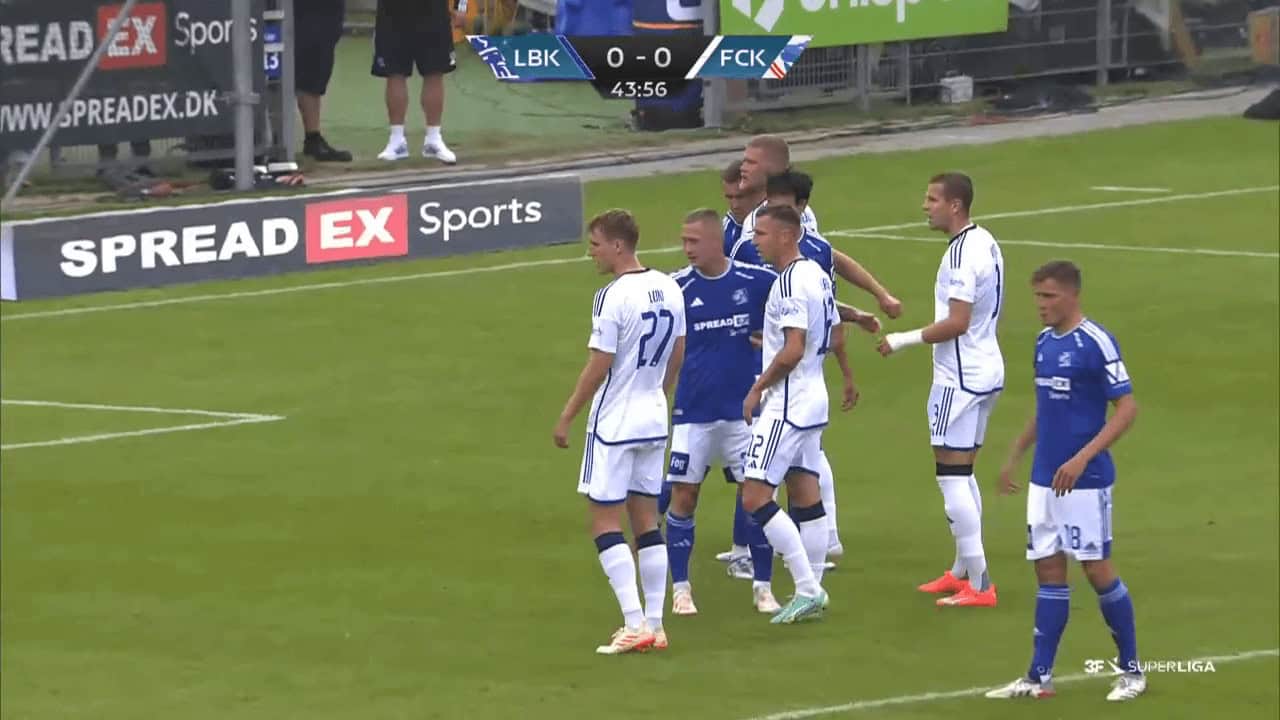
Below we can see another example of when København were able to outnumber the defensive unit around the penalty spot. The free player can be seen arriving at the six-yard box, where no defender is close to challenging for the ball.
The inability of defensive units to react to the extra numbers of attackers that København have been throwing into their attacks has meant that corners have been relatively easy to attack so far this season.
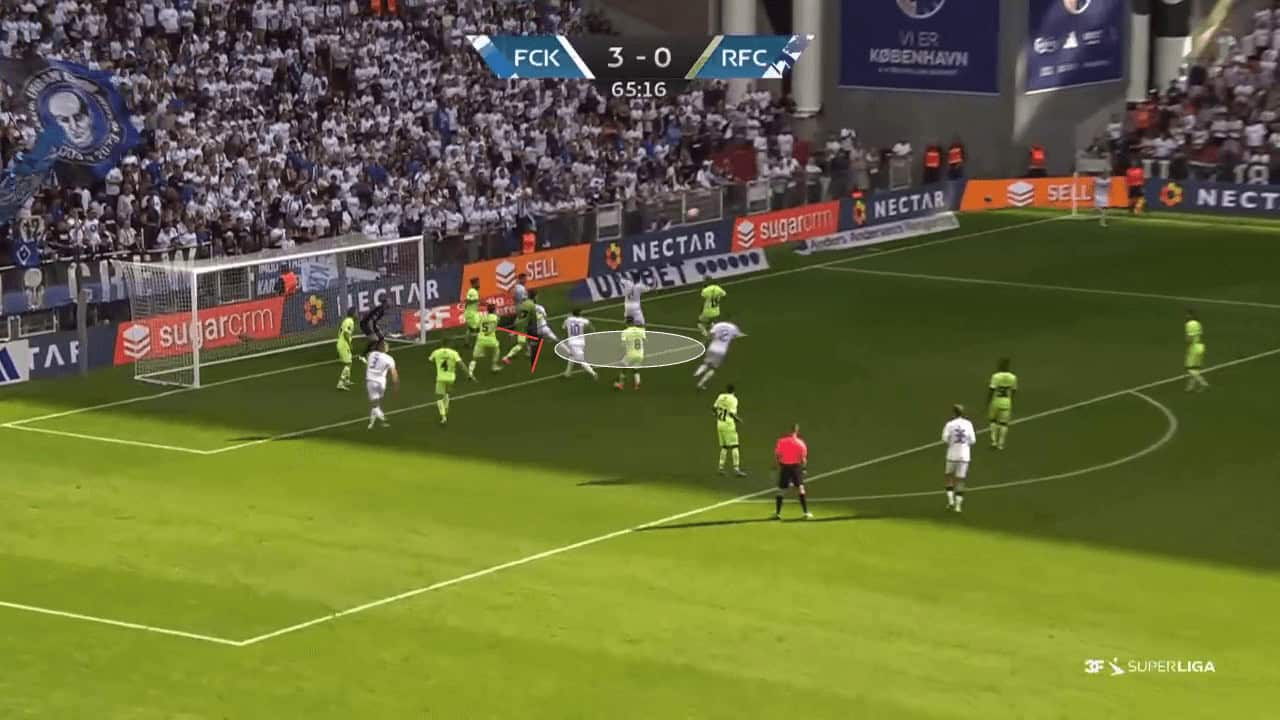
In order for players who arrive at the six-yard line to have the biggest chance of scoring a goal, FC København have attempted to clear those spaces for the potential attackers to arrive in those areas without any player competing for the aerial duel.
As with any corner kicks, there are two ways of protecting space: zonal defending or man-marking. The attacking unit’s deeper starting positions, usually around the penalty spot, mean that no man markers can defend those spaces at the six-yard line. Only a few zonal defenders are left at the six-yard line, with the man markers immediately removed from the target areas.
The example below shows that the defending side has two zonal defenders on the six-yard line. With the small number of zonal defenders, it becomes possible for København to immobilise those defenders. Immobilising defenders means preventing them from being able to attack the ball, which is likely to be achieved through the use of screens.
We can see two players screening the zonal markers, which allows any attacker who enters the white area displayed to attack the ball unopposed if they can create separation from their marker.
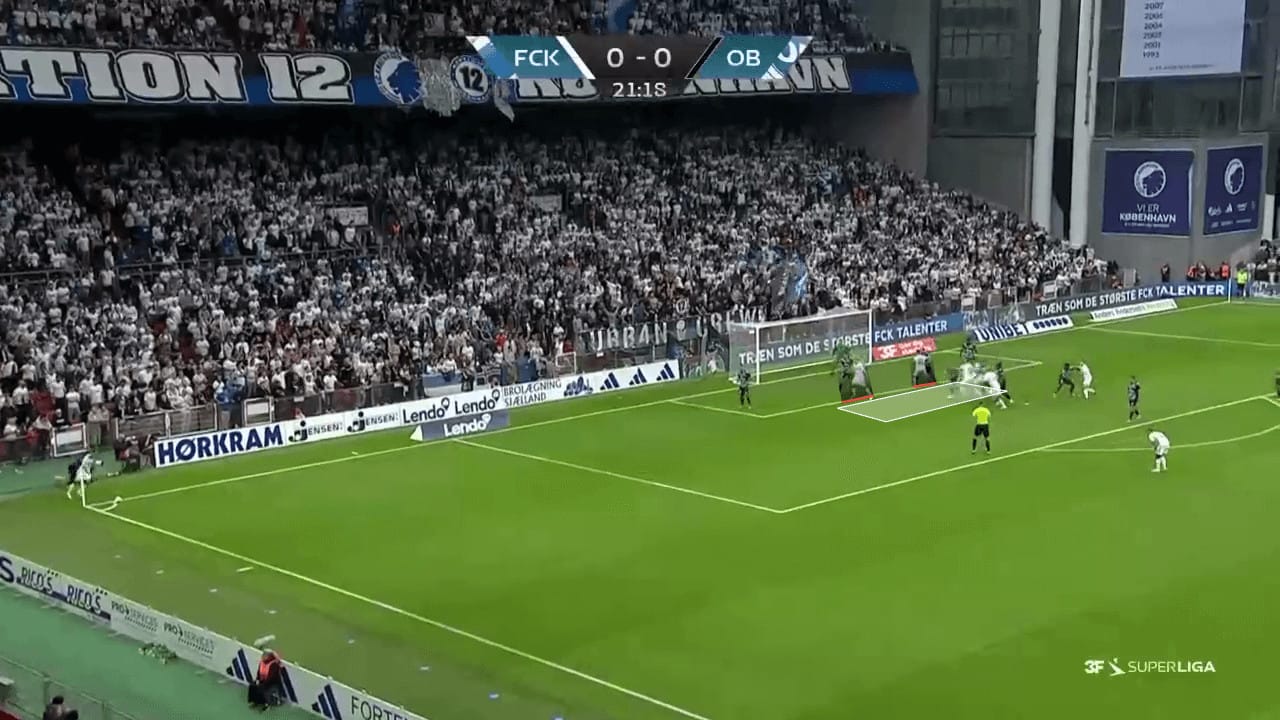
Below we can see another example of FC København using screens on zonal markers to create open spaces in those high-value areas which can be attacked by the deeper attacking unit.
The ability to disable any zonal marker from attempting to clear the ball boils the situation down to a bunch of 1v1 opportunities between each individual attacker starting at the penalty spot and their respective man marker.
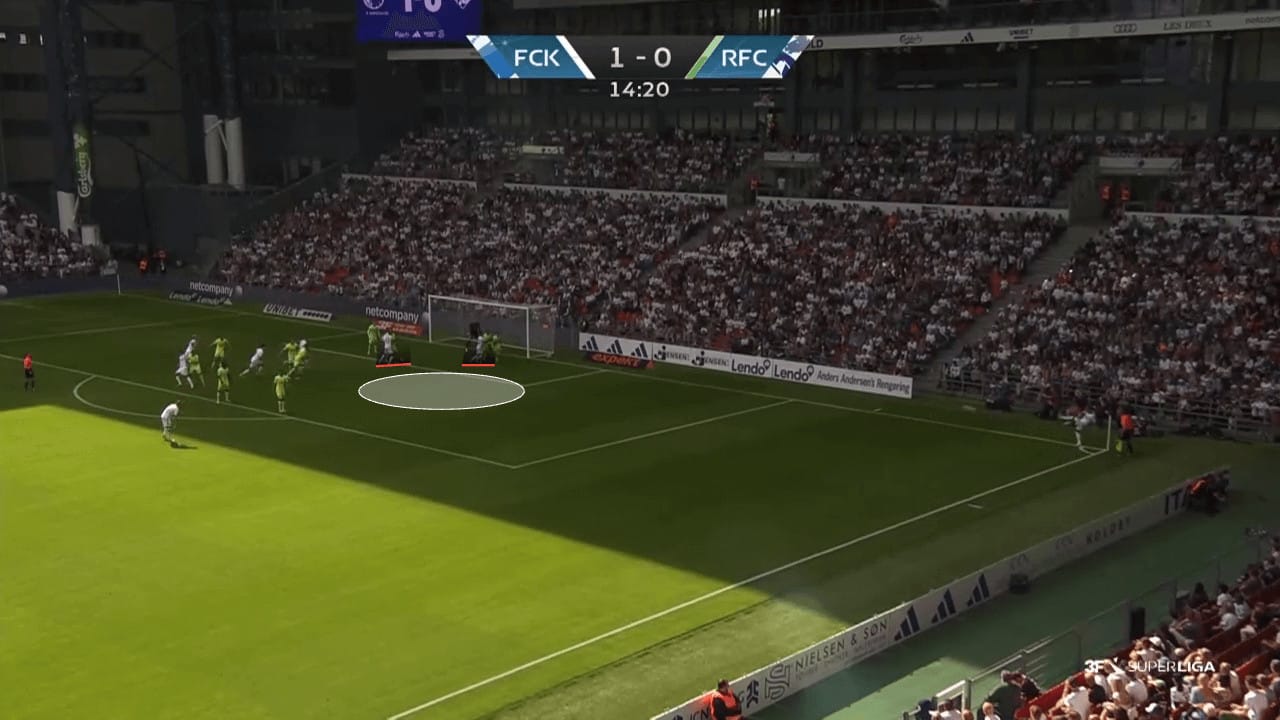
København have successfully created space and openings in dangerous areas, although there can be room for improvement in their 1v1 situations within the attacking unit.
The attacking unit can be seen spread around the penalty spot, where there is a 4v4. FC København’s preferred setup can be seen in the image, with four attackers while two players screen the six-yard box. Within that smaller attacking unit, København have attempted to create separation for one another through the use of screens.
At the penalty spot, the player highlighted in red has the task of creating a screen, whilst the player highlighted in green aims to attack the six-yard line unopposed.
We can also see two other attackers highlighted in white attempting to attack the ball. However, their roles aren’t pre-defined, and their intent to attack the ball brings a bigger crowd, making it harder for the target player in green to attack the ball without any interference.
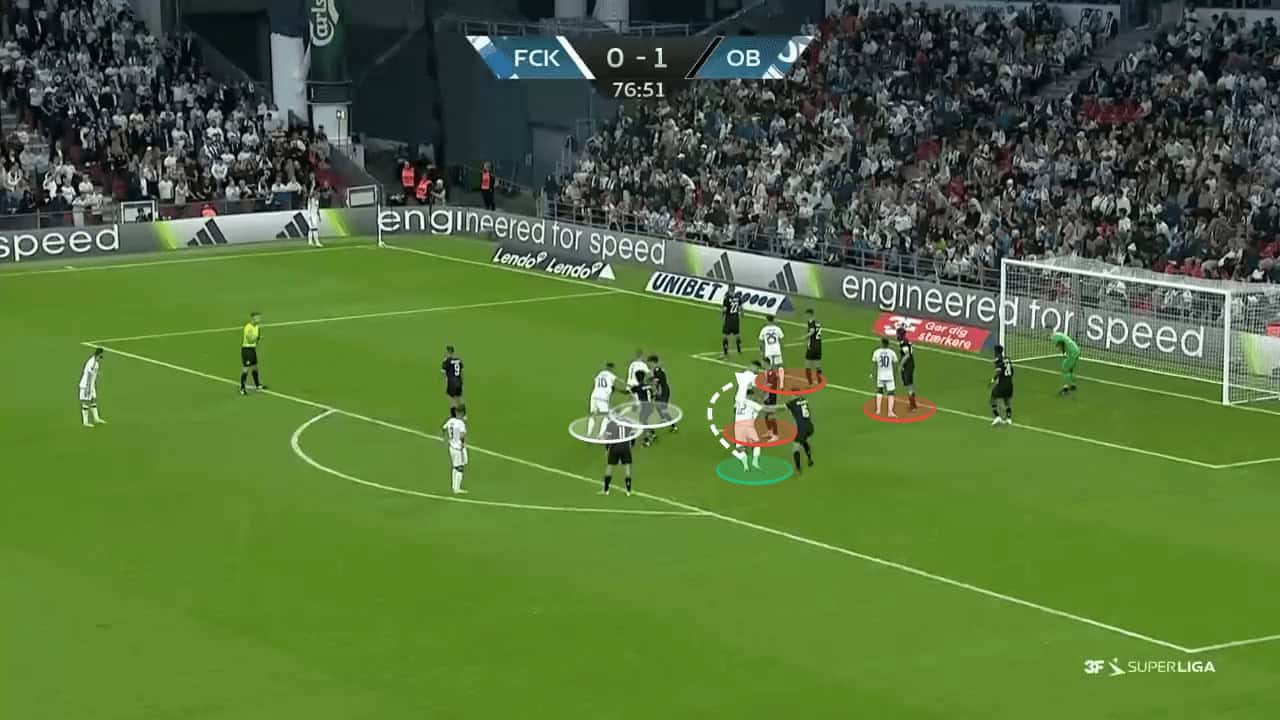
The screen can be seen in the shot below, which gives the target player the space needed to attack the ball unopposed. The multiple screens on both zonal defenders and man markers create ample free space at the six-yard line, creating a high-quality chance.
The timing of the run from the deeper attacker and the screen means that the player can attack the cross whilst still sprinting, ensuring that the headed effort has maximal power and can attack the ball before a defender can recover back into their position.
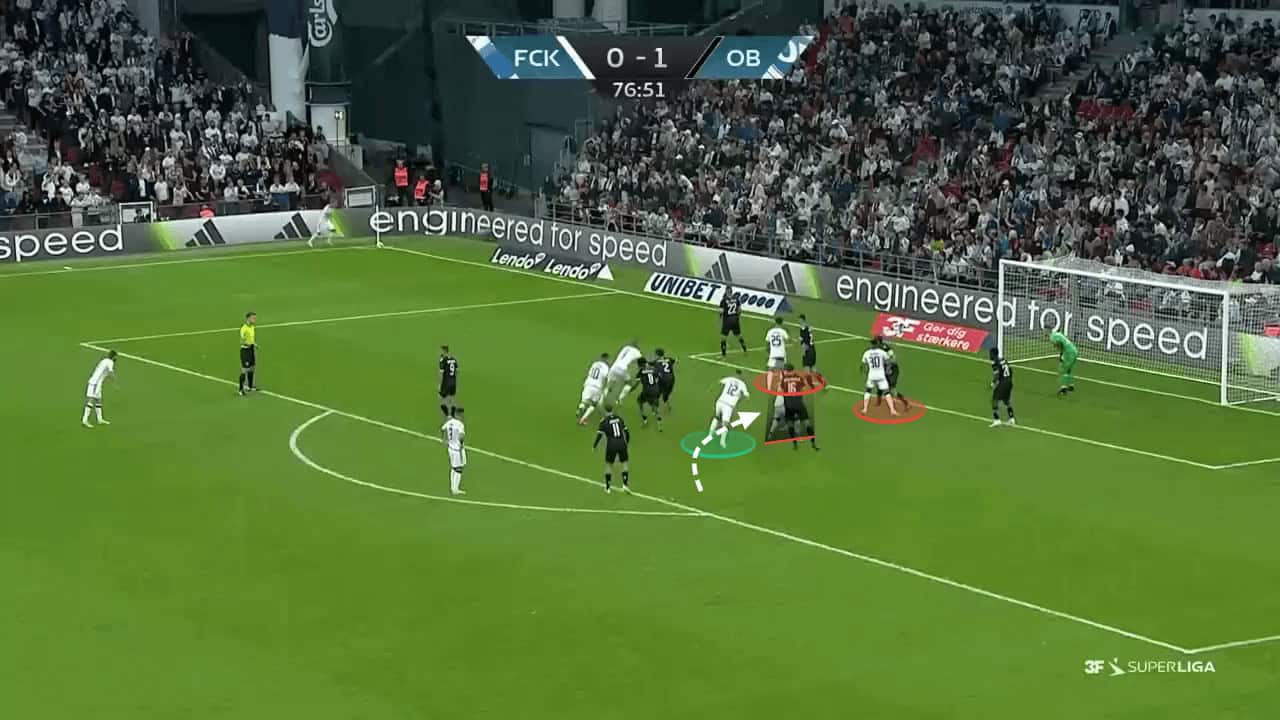
Deeper Starting Positions
One final way in which København have been able to create advantages in these 4v4 situations around the penalty spot has been through altering the starting positions, where the players edge towards the back half of the penalty area.
Changing the angle of an attack means that the defending players have to change their stance, with their backs facing the ball, if they want to have the attacker in their sight.
Having the defenders turn their backs to the ball has allowed København to perform these screens more easily, with the screen coming in from the defender’s blindside, making it more likely to be successful.
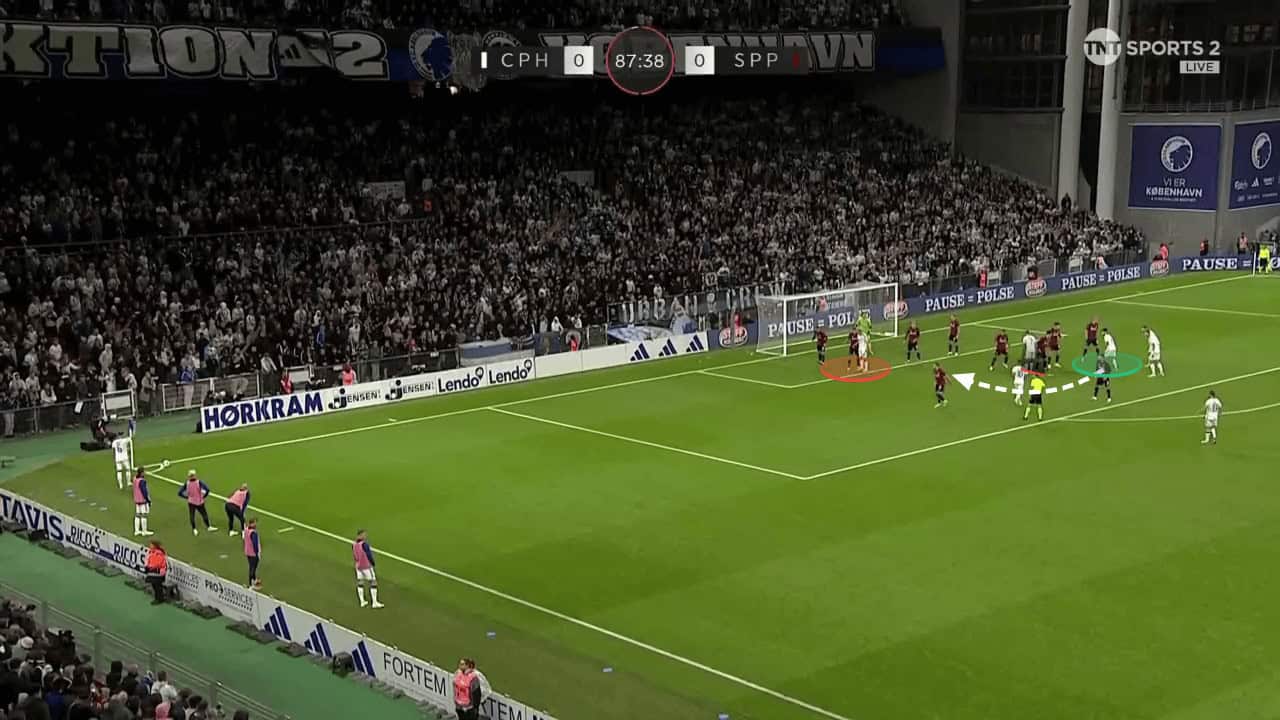
There have been some instances where heavier zonal defensive setups have meant that it became more difficult to gain access to high-value areas around the six-yard box. In efforts to draw the opposition away from the goal, København have utilised short corners.
The short corners provide defenders time to step away from the goal, which then provides the space between the defensive line and goalkeeper for the ball to be crossed towards.
Furthermore, having the ball played short draws the defenders’ attention to the ball, which means they cannot track any runners attacking their blindside. The image below shows how the defender has to keep their eye on the ball, to be prepared to react to the cross so they cannot see the players making the run over their shoulder.

Once the ball is crossed in and defenders scramble to get across to the ball, København then shift the ball to the opposite side again, where they have a 2v1 at the six-yard line. Any pass inside the penalty area causes alarm among defences in order to prevent an attacker from having the time or space to get a shot off. With the induced panic, the rash defending can be taken advantage of with an extra sideways pass, which is likely to find a white shirt as every defender becomes attracted to the ball.

Summary
This tactical analysis has displayed why København have been so efficient from corners this season and the different uses a screen can provide.
In the previous campaign, København used clever movements, near post-attacks and deep starting positions to create many dangerous opportunities. The set plays have evolved this season, with a bigger focus on using screens in order to have a more consistent method of creating chances from corners. Using runs from deep or attacking spaces at the near post proved to be effective, but teams could start to prepare for specific routines that were effective.
The only change this season is that København have added more weapons to their corner arsenal, with screens providing a new potential way of attacking corner kicks. The starting positions remain similar to last season. Still, now attackers have more options with which they can attack a corner, which has made them unpredictable in the early stages of the season, with them having scored a goal from a corner in 3 out of 4 league games after only 23 corners.
København can build on this further by increasing the chaos for defenders by potentially adding even more screens, decoy movements, or changing starting positions in order to provide the deeper attacking unit with added opportunities to lose their marker during their attempts to attack the six-yard box which is now easily accessible for the reasons stated earlier in the article.






Comments